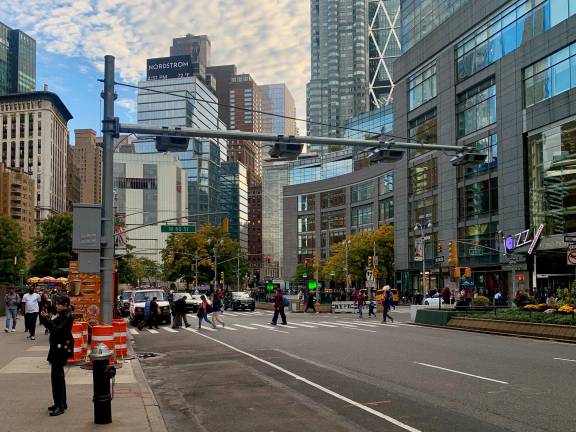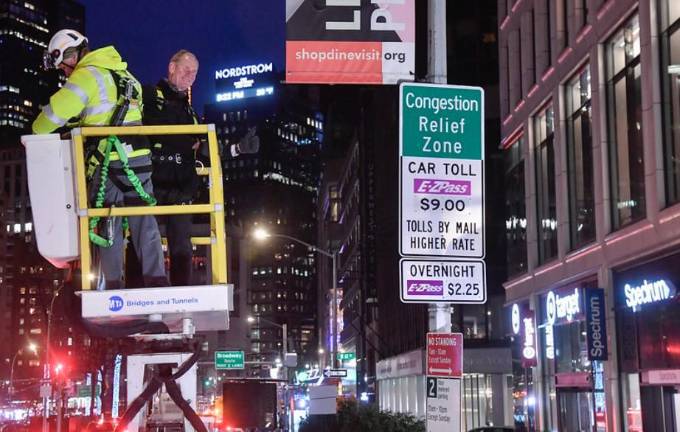Congestion Pricing at 1 Month: Faster Commutes but Slower Ambulance Response Times
Congestion pricing has cut traffic heading into the city. Ambulance response time is reportedly slower in the zone, however, and other in-zone traffic is only marginally better, if at all. And, oh yeah, Trump wants to squelch the whole program.
The controversial congestion pricing toll after its first four weeks has succeeded in reducing commute times into the city across bridges and through tunnels, but oddly traffic within the zone below 60th Street doesn’t appear to be moving appreciably faster.
According to the MTA, traffic in Manhattan south of 60th Street was down by 1.2 million vehicles between Jan. 5 and Jan. 31, a 7.5 percent drop. Holland Tunnel traffic is down by 48 percent while crosstown traffic on Canal Street is said to be 25 percent lighter. As to the mix, the MTA said that 57 percent of the vehicles entering the zone are passenger cars or vans while another 36 percent are taxis or Uber and Lyft rides. The Taxi and Limousine Commission said that at least during the first week of the program that taxi rides were up 10 percent.
While commute times were way down and there were tens of thousands fewer cars on the streets, the indie website Congestion-pricing-tracker.com found traffic flow within the zone was barely changed compared with the same weeks a year earlier, while uptown traffic outside the zone ticked up mildly.
“Throughout the month, we have continued to see dramatic decreases in traffic on bridge and tunnels, smaller increases in traffic on some spillover routes, and marginal decreases or no change on within-congestion zone routes,” wrote Benjamin and Joshua Moshes, who started the site.
Ambulance response times, one of the big carrots that the MTA dangled, don’t appear to have sped up at all.
A recent report in Crain’s New York Business said the 11.7 minute response time through the first three weeks of January was actually a minute slower than the same period in 2024. For non-life-threatening emergencies in the first three weeks, the ambulance response time was 24.3 minutes, Crain’s NYB reported, and that is five minutes slower than the average in the same weeks a year ago.
The biggest questions are still up in the air: How much money is the toll raking in? And is the MTA on target to collect about $600 million annually from the tolls to finance between $15 billion and $16 billion in borrowing for long-term capital projects.
Congestion pricing into Manhattan below 60th Street started on January 5 with most vehicles with E-Z Pass paying a $9 fee for passenger vehicles between 5 a.m. and 9 p.m. In the off hours, the E-Z Pass toll drops to $2.25.
President Donald Trump on Feb. 9 told the New York Post he wants to eradicate congestion pricing. How? By holding New York City’s share of the $36 billion in five-year federal transportation funding to New York State. Trump vowed to rid Big Apple streets of bike lanes as well.
Trump claims the toll is hurting business in his hometown.
“Traffic is way down because people can’t come into Manhattan, and it’s only going to get worse,” he said. “People don’t know about it until they get the bill,” he mentioned in the interview.
The MTA said it seems river crossings are 10 to 30 percent faster than before congestion pricing. The crosstown traffic on Canal Street is said to be down 25 percent.
There are certain exceptions, notably the Hugh Carey Tunnel in the evening rush hour. As an eyewitness to this speed-up, this Straus News Manhattan reporter came back from Newark Airport through the Holland Tunnel in about five minutes from the toll barrier to Manhattan. No ride into Manhattan has ever been that quick in this person’s experience. Conversely, the tunnel from Brooklyn shows little evening rush hour variation from before congestion pricing, as it is a main route for trucks going to Manhattan.
On Feb. 4, Sen. Kirsten Gillibrand on the Brian Lehrer Show on WNYC suggested there still need to be some tweaks. The toll charges, she said, have harmed working people who need cars for their jobs. She also urged new exemptions for firefighters, nurses, first responders, some public servants, and Staten Island residents. The MTA has warned such exemptions to the tolls would force them to raise the price for everyone else, and would kill many of the traffic-reduction benefits that New Yorkers have been promised.
“Before the start of congestion relief, talk of lawsuits and doubts dominated the conversation, but now it’s the undeniably positive results we’ve been seeing since week one,” said MTA Chair and CEO Janno Lieber.
A Morning Consult poll on Feb. 3 noted that 59 percent of people believe President Trump should “allow congestion pricing in New York City to continue” instead of halting the program. The poll shows 51 percent of respondents who drive into the congestion-area zone at least a few times per month support the tolls.
Ultimately, the jury may still be out on how well the tolls are helping traffic flow, cutting air pollution, and, most important, raising the money the MTA needs to make mass-transit improvements.
“While we now have great certainty in these early impacts, we still caution against drawing conclusions about the program’s overall effectiveness,” wrote Benjamin and Joshua Moshes, who are now going to update their congestion-pricing-tracker.com results only monthly instead of weekly. “Traffic may deviate from these patterns as New Yorkers continue to adjust to the program, so the program’s long-term impacts cannot be judged just yet,” they said, adding, “We are also watching news about the possible suspension of congestion pricing.”
Indie website Congestion-pricing-tracker.com found traffic flow within the zone was barely changed compared with the same weeks a year earlier, while uptown traffic outside the zone ticked up mildly.

